Kirtland Country Club
OH, USA
Green Keeper: Chad Mark

Those unfamiliar with the beauty of the eastern suburbs of Cleveland are often shockedby the stunning landscape of Kirtland Country Club. Pictured above is the downhilltenth with the long one shot eleventh in the background.

Golf at Kirtland represents a study in playing angles. As seen above from the thirteenth tee, does thegolfer accept the risk of going down the hazard side of the hole (i.e. the right) for the reward ofa better angle into the green?
Of all the great Golden Age architects, the body of work by Charles Hugh Alison may well be the least understood and appreciated. There are several primary reasons why this may be the case. First, he built less than thirty-five original designs over a career that spanned nearly fifty years. This a relatively small number of courses, especially by modern standards. Even among those thirty-five, many were under the banner of Colt & Alison, creating confusion as to when Alison alone deserves the credit. Second, his finest designs are so far flung around the world that few have had a chance to see them. From his early days of working with H.S. Colt in England in the 1910s to working in the United States of America in the 1920s to working in Japan and the Netherlands in the 1930s and finally to Johannesburg in South Africa where he died in 1952, he left behind a trail of courses that are considered among the best in each country. And finally, third, a few of his very best designs no longer exist, robbing him of the accolades that he would otherwise receive.
In the United States, Timber Point was his crowning achievement. Situated on a promontory on the south shore of Long Island, the course enjoyed an expansiveness and scale rarely found. According to Daniel Wexler in The Missing Links, With its tremendous challenge, variety, and ambiance, this golf course would unquestionably still hold a position among anyone’s very best.’ The three nines that exist at Timber Point today are a poor substitute for what was once there. Likewise, several other of his most notable designs have fared poorly with time. Bob Jones’s love of Alison’s original holes at Sea Island is well documented though the course has sadly been altered several times since. Burning Tree outside of Washington D.C. is a feature rich design that has also had one too many architects touch it.
As they exist today, the two finest examples remaining of Alison’s work and skill in the United States can be found at Milwaukee Country Club and Kirtland Country Club. Ironically, both have first nines that play across rolling topography while their second nines descend and play along a river valley. Designed in 1921, Kirtland was one of Colt & Alison’s first projects in the United States and preceded Milwaukee Country Club by eight years. Its success was immediate with professionals like Bob Jones and Walter Hagen speaking of it in glowing terms. A generation later found Gardner Dickenson detailing hole by hole the back nine after having last played it thirty years ago. Arnold Palmer too is a fan, having played numerous rounds here while stationed in Cleveland during his Coast Guard years. Native Buckeye Tom Weiskopf (who grew up in Cleveland) considers Kirtland the best in golf rich northern Ohio. Joining a long list of top golf professionals captivated by Kirtland’s challenge is Tim Bennett, who left Oakmont and Bob Ford in 1991 for the sake of becoming the head professional here. What makes Alison’s work so endearing? Few have studied Alison’s work as much as historian Tom MacWood. In fact, his piece entitled Gliding Past -Fuji – C.H. Alison in Japan is a must read (click here do to so) for anyone interested in understanding Alison’s approach to design. As MacWood notes,
Alison has a very interesting design style – quite different from his mentor Colt. In some ways it more closely resembles the style of Macdonald, Raynor and Langford. Steeply elevated pushed-up greens and bold bunkering – bold in both their scale and severity. The combination of these perched up greens steeply falling off and the deep bunkers forces the golfer to carefully consider his tee shot, and what angle of approach is favored. This clearly man-made method to making greens was combined with an inclination for using big natural features. You will often find rivers, streams, wetlands, ravines and other dramatic elevation changes incorporated into Alison’s designs, often in very daring ways. That in my mind is American design approach. The fact that Alison assimilated a heroic American style should not come as a total surprise, after all he spent his early design years in the States (his most productive years as well), at a time when one could argue American design was at its zenith.
Fortunately, unlike most Alison courses, Kirtland has never let lesser architects tinker very much with its course. Regardless, with time comes issues and by the mid 1990s, the board at Kirtland reached out to Forse Design with the desire to improve its bunker drainage. One walk around this property and Ron Forse was another to fall under Kirtland’s charm. The scope of the project grew from drainage to a full restoration of all the bunkers to recapturing fairway width and to reclaiming putting surface out to the edges of Alison’s large green pads. From Forse’s original visit, work didn’t commence in earnest for ten years. Once it did in August, 2007 through April, 2008, a tremendous amount was accomplished with one primary result being that Alison’s fascinating playing angles were brought back to the fore as we see below.
Holes to Note
First hole, 410 yards; The mandate from the club during the construction phase was one of ‘tasteful restraint.’ This worked well with the approach preferred by architect Ron Forse and associate Jim Nagle who appreciate how easy it is for an architect to impose his will on a golf course – and the pitfalls in doing so. According to Forse, Alison never ‘fancied-up’ his designs with clutter but rather relied on the broad scale of his features to tie in well with the natural setting. ‘Quiet elegance’ is the term that comes to Forse’s mind in describing Alison’s work in general and here at Kirtland in particular. At the first, trees were removed on the inside of this slight dogleg left which set the stage for the new left fairway bunker and expanded fairway. Up ahead, a non-Alison left greenside bunker was removed and and well over one thousand square feet of putting surface was recaptured. Nagle is particularly pleased how approach shots played away from the deep right greenside bunker now may seem safe given that the green is larger and the left bunker is gone. However, shots played from the left to this ferociously pitched back left to front right green are treacherous. The overall effect of Forse Design’s work was to clean up the appearance of the first hole while at the same time re-instating Alison’s intended challenge, both of which they handsomely accomplished. Second hole, 465 yards; The job of every architect is to use the natural land contours to maximum advantage. Few were better than Alison at routing holes in every conceivable manner over the land, thus creating highly distinctive holes. Unlike the first which plays through a shallow valley, the second fairway disappears over the crest of the hill before swinging right toward the green. Only the longest drives reach the crest; for most the drives hit into the hillside, negating much run. The resulting approach shot from over 200 yards is frequently blind. Not the most dramatic hole on the course, it may nonetheless be the toughest.

Alison’s courses enjoy a sense of scale and purpose. When on the more gentle portion of the property,Alison created bolder features like this twenty yard wide bunker right of the second green.
Third hole, 165 yards; Aesthetically, the restoration work dramatically improved this hole as seen below. Fundamentally, the challenge remains the same though which is to hit the green and stay below the day’s hole location on this sharply tilted back to front green.
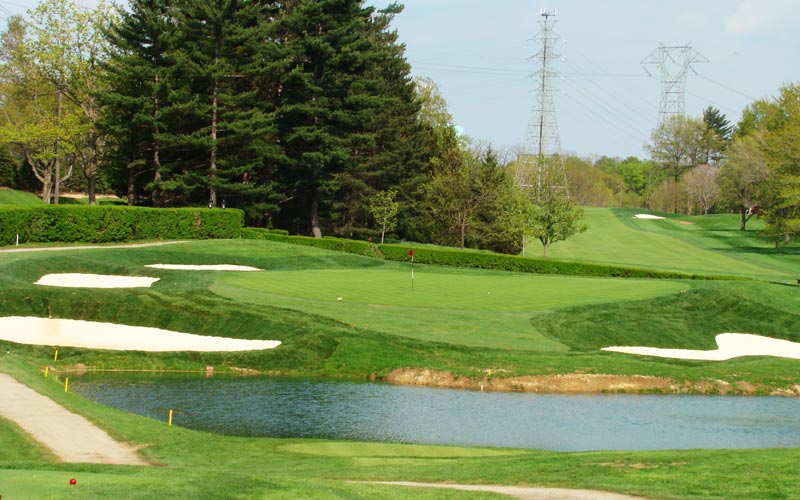
Referred to as ‘Alisons’ at his world class courses in Japan, Alison built his bunkers to be true hazards.Such is again the case at the third at Kirtland where the merits of Forse Design’s restorationhandiwork above is best appreciated by comparing the bunkers today to…
…the two dimensional bland bunkers in this 2006 pre-restoration photograph.Seventh hole, 380 yards; A lesson long learned from the study of the Old Course at St. Andrews is the use of out of bounds. Here at the seventh, the golfer needs to drive down the out of bounds side of the hole (aka the right) to be rewarded with the best angle into the green. As the golfer shies away to the left, the green’s left to right tilt becomes increasingly problematic. Even better, eight yards of the back left corner of the green was recaptured by Forse and the only way to access such new hole locations is from the right portion of the fairway. To still provide a challenge, a hole of this modest length needs to have a well defended green, which this one does with a six to eight foot drop off behind and to the right. Indeed, standing on the eighth tee and looking back, the golfer wonders where Alison got the dirt to build up this green pad.
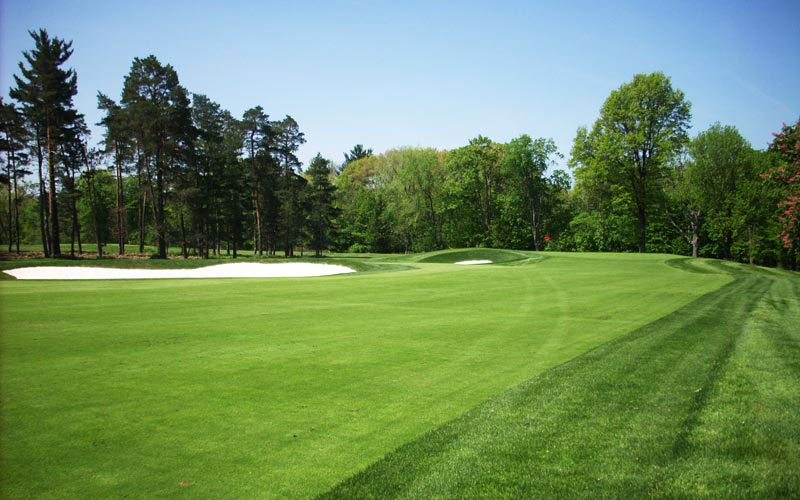
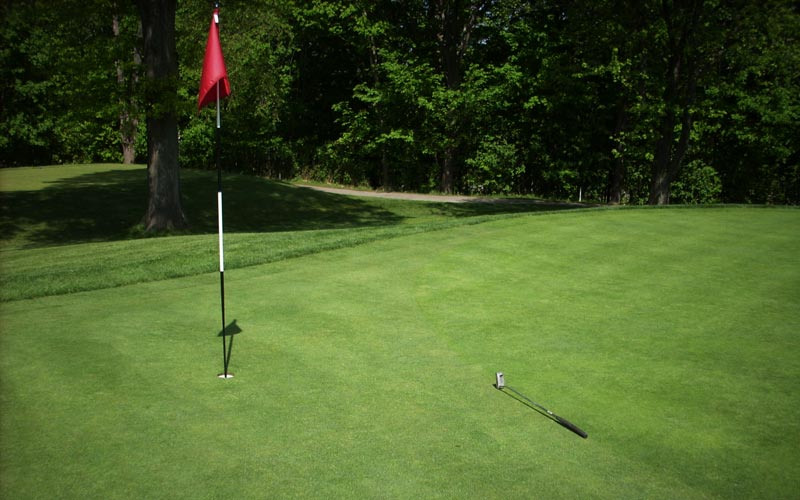
Everything left of the putter is the new putting surface that was recaptured based onstudying a 1938 black and white aerial.
The green expansion work commenced in August, 2007 and concluded in May, 2008. As seen above, it is already difficult to tell where the expansion work was carried out, so well done is the technique that was employed. To understand more about this process, please click here. Eighth hole, 535 yards; Starting with this blind tee ball over the crest of a hill, the golfer is transported into some of the most exhilarating golf country found on any inland course in world golf. One dreads the thought of what most modern architects would do to the hillside off the tee. By leaving it alone, Alison helps the golfer gain a sense of the property’s natural movement. Alison was particularly adept at incorporating the most exciting natural features of a site into his routing. The wilder the land, the more distinctive the holes, as witnessed at Hirono in Japan, Royal Hague in the Netherlands, and here at Kirtland.
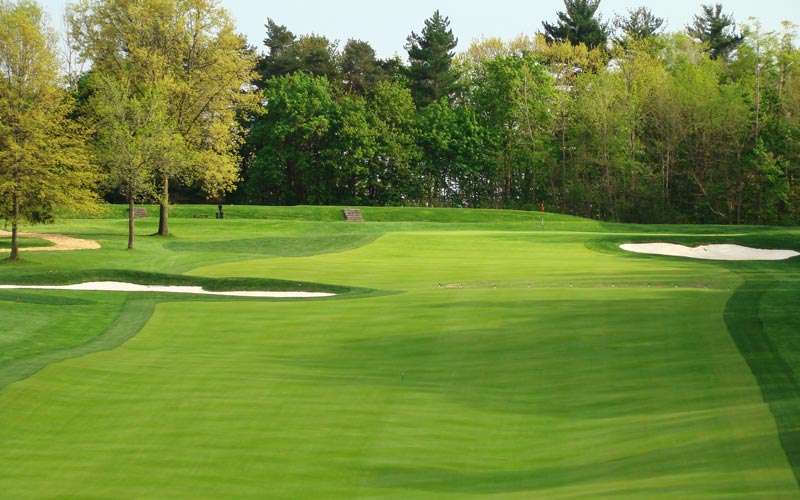
After clearing the crest of the hill with his drive, the golfer is greeted with this view of the eighthfairway as it sweeps uphill. Forse prudently shifted the bunker seventy-five yards short ofthe green from the right (its old footprint is barely visible) to the left side.No Golden Age architect would line out of bounds with a bunker asdoing so lacks any strategic merit.
Ninth hole, 425 yards; The first nine starts with a green angled from front right to back left that tilts toward the golfer and concludes with a green angled from front left to back right that feeds away from the golfer. In between, holes play through valleys (e.g. the first, fourth, and fifth) and up and over hills (e.g. the second and eighth). The best is saved for last though with this fairway playing along the spine of the hill and a green with mirror image redan playing characteristics.
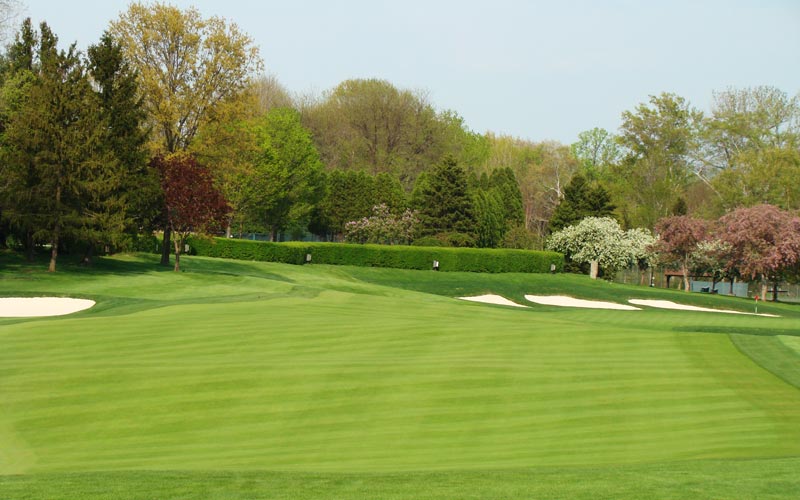
The crowned ninth fairway falls away both left and right, making it difficult to hit.

Seeing an approach shot take the left to right slope and feed thirty yards to the right holelocations is one of the most fun/rewarding/satisfying shots at Kirtland. It alsospeaks in glowing terms of the maintenance practices here.
Tenth hole, 525 yards; As the first nine stays on the high portion of the property, it gives no hint as to what the golfer may expect standing on the tenth tee. Far, far below is the fairway, situated in a river valley in which the golfer stays until the Home hole. To get a good drive away is one that lingers in the golfer’s memory as he watches the ball fall from the sky for what seems to be an eternity. More importantly, a good one brings the green within reach in two, which is especially important given the difficulties of the next two holes. Interestingly enough, the tenth goes from a reachable par five from the blue to a daunting 460 yard two shotter from the white markers. Nonetheless, at 6,435 yards from the middle tees, Kirtland is an absolute joy to play. Though the dramatic views from either tee naturally steal the show, the green itself is a marvel with Alison’s intricate subtle interior contours having befuddled golfers for years.
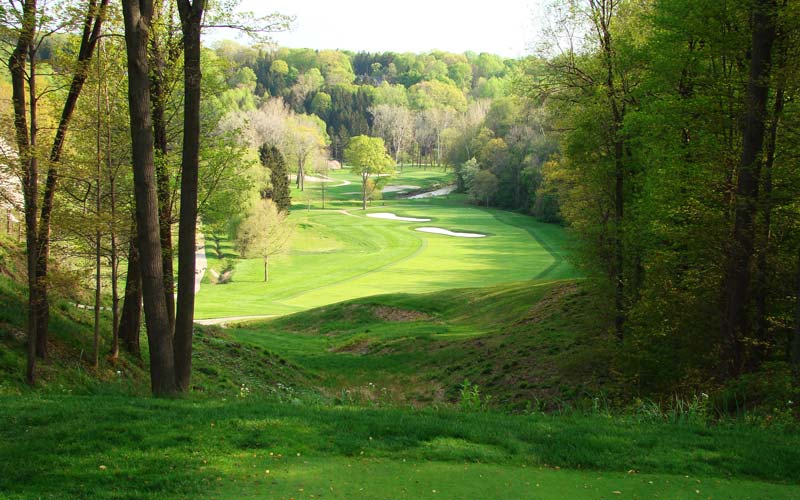
The spectacular view in the spring from the 525 yard tee at the tenth. Move forward and..

…and here is the view from the 475 yard tee box.
Eleventh hole, 225 yards; To compare the beauty and playing merit of the eleventh at Kirtland to that of the tenth at Banff Springs in the Canadian Rockies speaks as to the captivating setting that Kirtland enjoys. In terms of lending courses maximum variety, most Golden Age architects strived for building one par three that required a wood into the green. Rather than just being a brute, Alison added drama simply by putting the tee boxes on one side of the stream and the green on the other side, 200 plus yards away on the inside of the stream’s elbow. By following nature’s lead and incorporating the stream into the hole in such an ideal manner, Alison created a hole of timeless appeal – and lasting challenge.
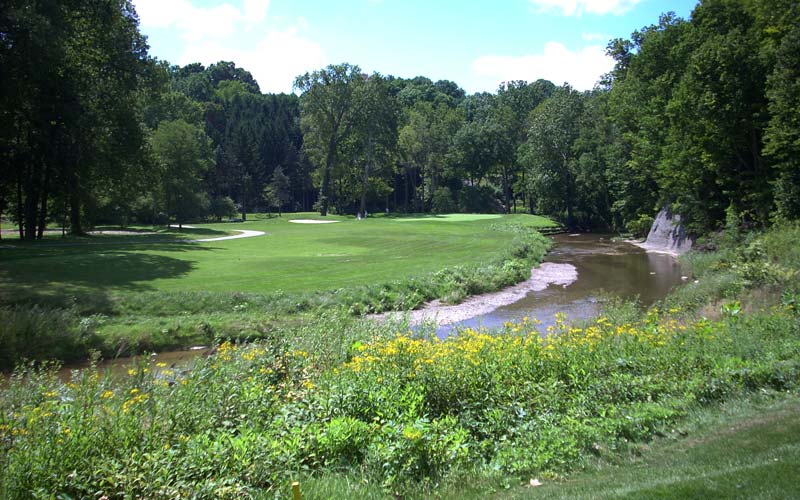
As seen from the tee, Alison’s simple use of the stream provides maximum drama with only the confidentgolfer able to hold his tee ball straight enough to find the green on this long one shotter.
Twelfth hole, 450 yards; Considered the finest hole by many members, the twelfth has it all: a great setting, a roaring stream, scale, and superb interior movement found within its green.
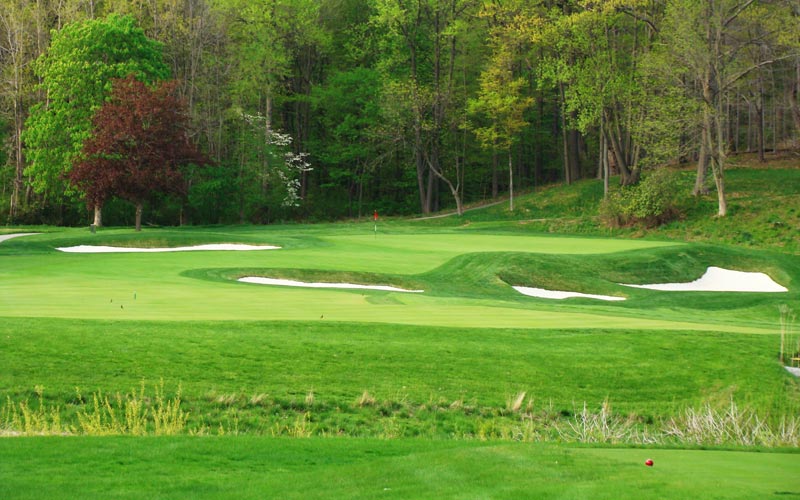
From the back markers, a carry of 210 yards is required to cross the stream and reach the fairway. Alison employed cross hazards as a way to make golfers of all abilities continually have to think. Case in pointis the restored cross hazard directly in line with the flag above. Eighty yards short of the green,this bunker effects the tiger golfer who has missed his drive into the rough or themore modest golfer in equal measures.
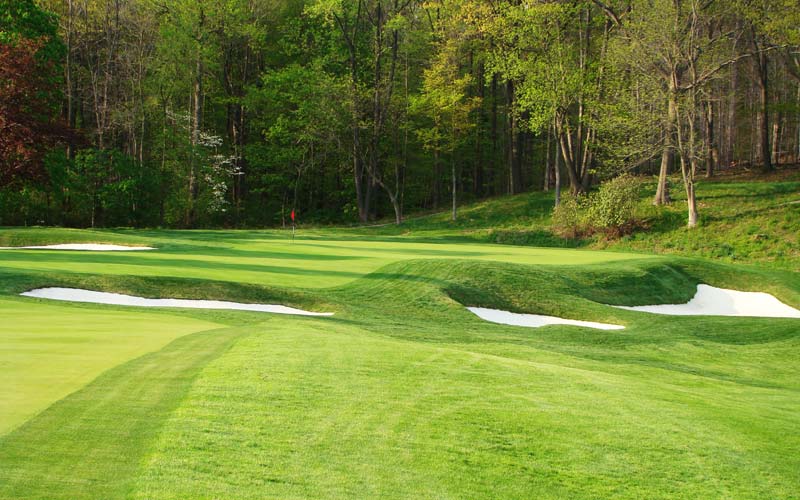
The golfer enjoys watching his long approach shot drop down against theattractive backdrop of the hillside behind the green.
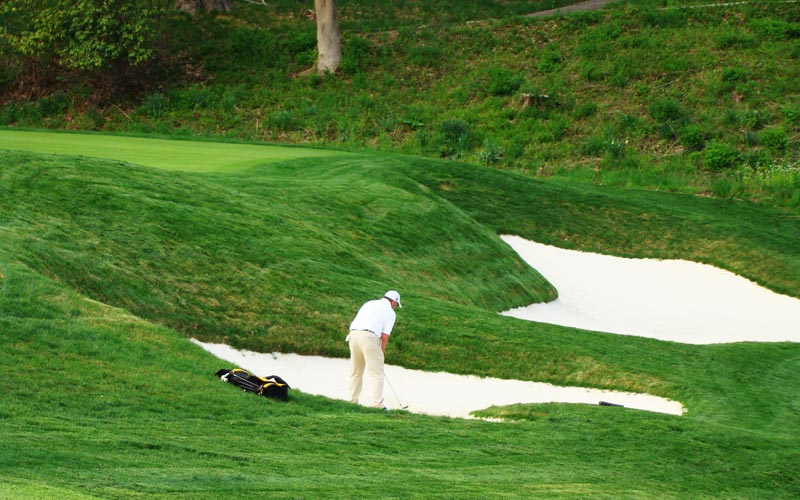
Every feature at the twelfth is on a heroic scale including the deep greenside bunkering.

Looking back down the twelfth. No matter the office worries, the golfer soaks up being alone in nature.
Thirteenth hole, 370 yards; The elevated tee provides a striking view of the roaring stream and the short par four to its left. At 3,300 square feet, the pushed up green represents the smallest target on the course. Thanks to the skill of Green Keeper Chad Mark and his crew, the greens are guaranteed to be firm and thus it’s imperative to hit the fairway; otherwise, holding it is a real challenge. Ala the seventh, the green’s left to right tilt places a premium on hugging the side of the fairway where more trouble lurks.
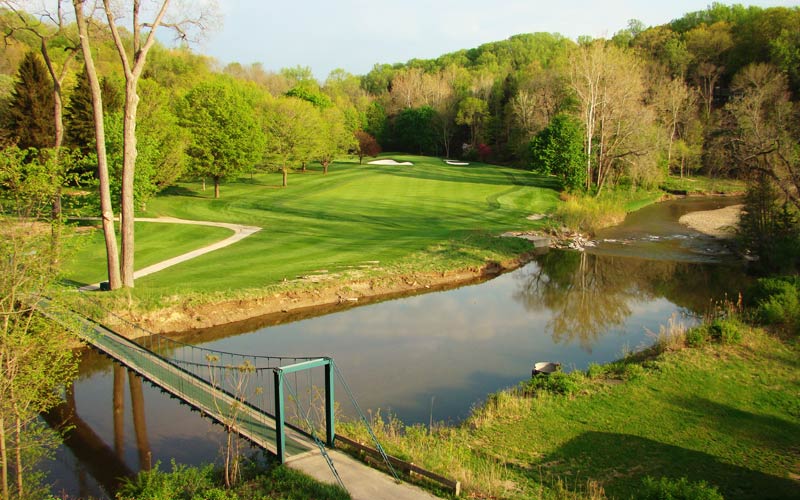
Kirtland is a walker’s delight. Assuming one takes the funicular after the seventeenth, the longestgreen to tee walk on the second nine is seventy yards and that is to reach the elevated thirteenth tee. Once there, the golfer is rewarded with this glorious view.
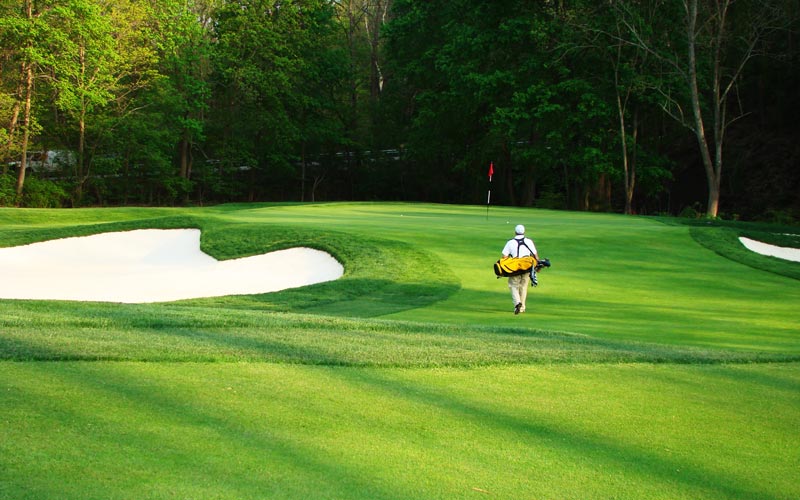
Though the thirteenth comes in the middle of a stretch of holes that are more overtly demanding,its tiny green is a frustratingly difficult target to hit with regularity.
Fourteenth hole, 425 yards; The fourteenth is the only hole on the course with less than six feet of elevation change from tee to green and it provides a respite from the stream. Having said that, a par here is elusive with out of bounds along the right having the desired effect of pushing golfers too far left. Similar with the seventh hole, the reclaimed back left portion of the green only opens up to those golfers that play down the out of bounds side off the tee.

There is nothing cluttered or complicated about the drive from the fourteenth…other than the out of bounds down the right (!).

With no natural hazards with which to work, Alison created his own including this large central hazard sixtyyards short of the green. The reclaimed back left putting green is evident in the photograph above.
Fifteenth hole, 505 yards; From a scoring perspective, the good news about playing in a river valley is that it typically yields a number of relatively level lies. Here too, after the tee ball clears the stream, the golfer is likely to draw a good stance/lie and he may well find the green within reach. However, the going gets more complicated as Alison routed the last eighty yards of the fifteenth up the base of the river valley wall. Angled from front left to back right, the green makes for a tough target to hit, be it with a three wood or wedge.

The golfer crosses the stream for the last time with his tee ball at the fifteenth.
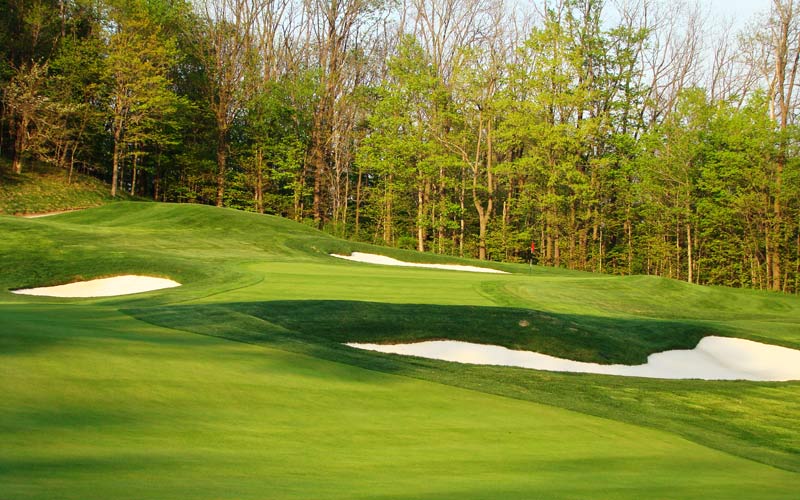
The last eighty yards of the fifteenth rises uphill to a green angled from front left to back right.
Sixteenth hole, 365 yards; Max Behr’s Ëœline of charm’ has been returned to this hole with the removal of trees on the inside of the dogleg right. Prior to 2007, trees helped guide/steer the golfer to the outside of the dogleg, from where the angled green opens up. Now, the greedy golfer sees the last eighty yards of the fairway as it climbs toward the green. What golfer isn’t tempted to bit just that little extra off the dogleg?
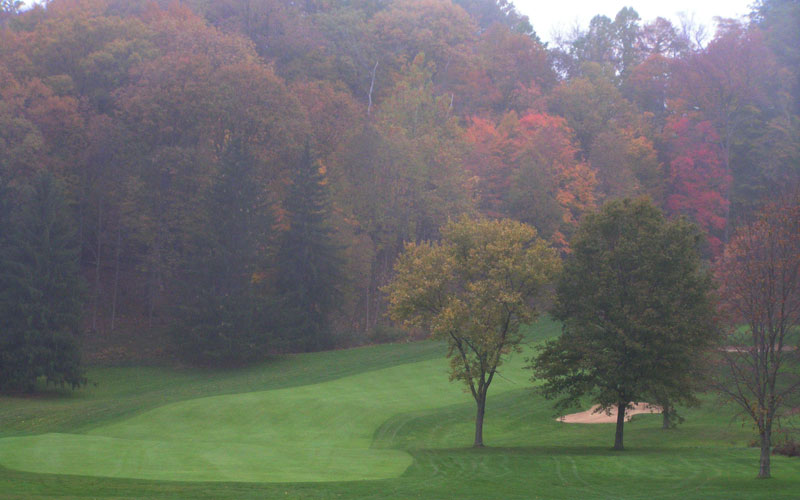
Taken in the fall of 2006, trees once obscured a view of the last eighty yards of the sixteenth hole.
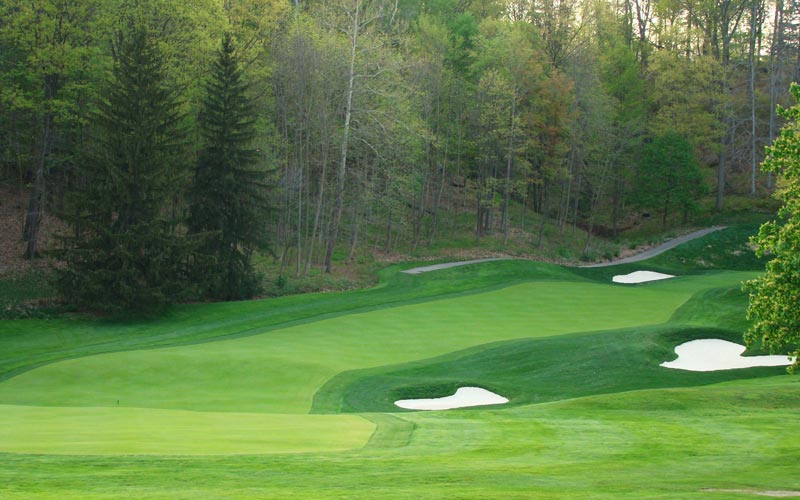
Such is no longer the case and better golfers are now inadvertently drawn into attemptingtoo big a carry across the corner of the dogleg.
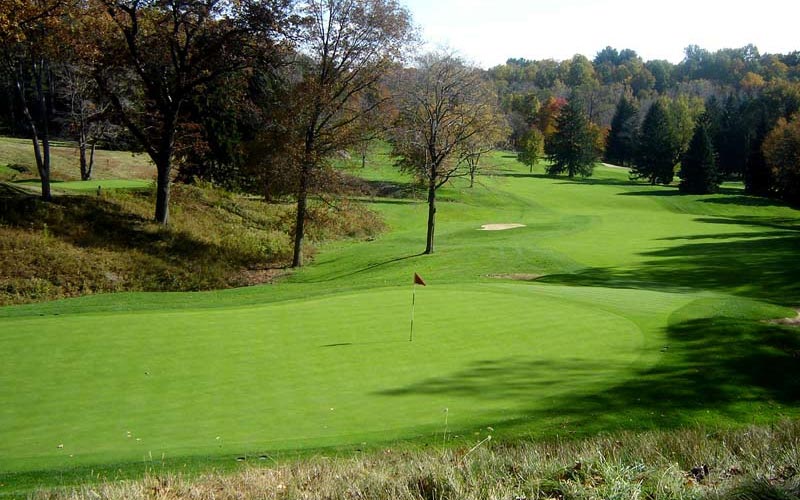
In the pre-restoration photograph from behind the green, one sees how the green’s axis pointsto the outside of the dogleg. Trying to cut off too much from the tee oftenleaves a difficult recovery angle from the right rough.
Seventeenth hole, 195 yards; Played across a valley, the green is the most heavily bunkered one on the course. Five small bunkers line its left side but it is the nine foot deep pit eating into the right of the kidney-shaped green that inflicts the greatest damage.
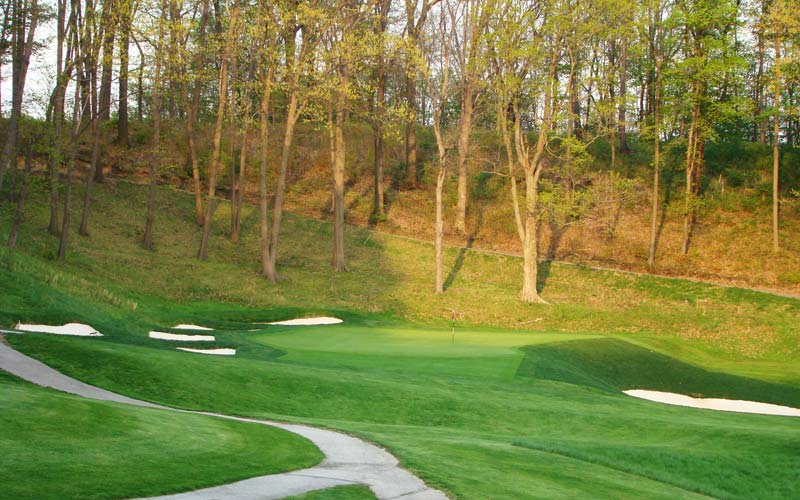
Despite the scar of the cart path, the seventeenth is a most attractive one shotter. Note the new hole locations that were created by the back right green expansion. Overall, the Kirtland greens went from 120,000 to152,000 square feet in total size but the true impact of the green expansion project is bestappreciated in the context of the recovery of such great hole locations.
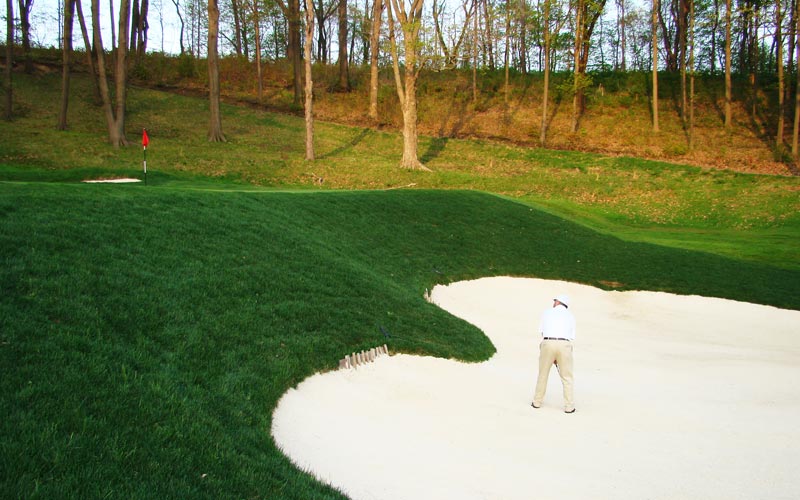
A very difficult recovery shots faces the player that misses the green right.
Eighteenth hole, 425 yards; What a pity it would be for this sterling nine to end with anything other than a unique Home hole. Thankfully, Alison delivers with a crescent shaped hole that wraps left around the rim of the river valley. The seventeenth hole and sixteenth green are on the inside of this dogleg left, literally one hundred and fifty feet (!) below. A draw over the brow of the hill that stays in the left half of the fairway sets up the golfer with the best approach angle to this green, which is guarded by a sole deep bunker front right.
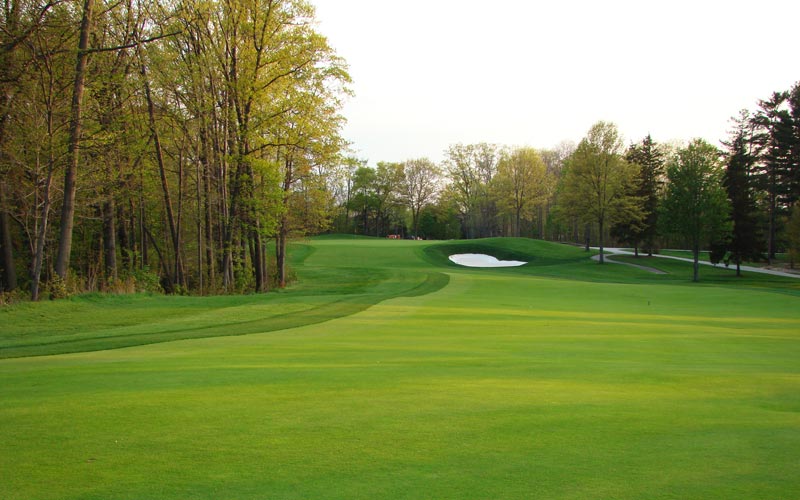
Any shot that clatters into the trees on the left can literally roll one hundred and fifty feet downhill.Armed with that knowledge, golfers have played out to the right for decades,which makes for a longer and more difficult approach.
One thing is for sure: the back nine that so mesmerized Gardner Dickinson still lives up to its billing as one of the great nine holes in golf. Just the walk itself is exhilarating, descending from the tenth tee into the river valley, crossing bridges on the next three holes and again at the fifteenth before taking the incline to the eighteenth tee. This is inland golf at its most rich potential.
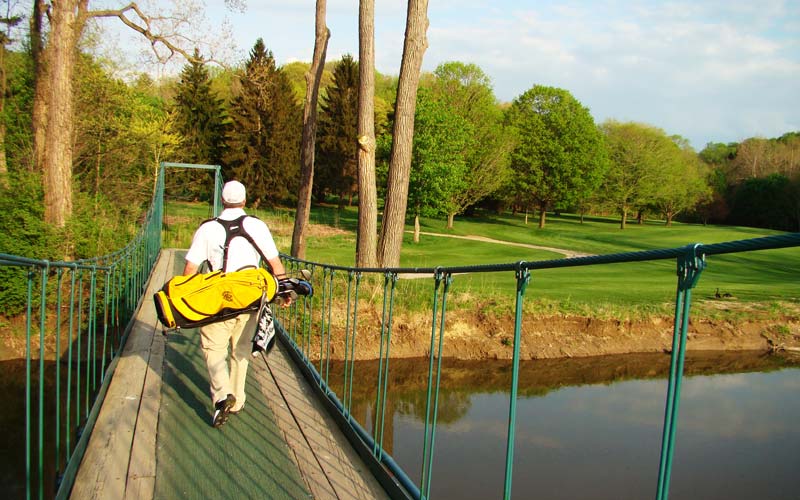
The tenth tee shot drops the golfer into a beautiful river valley from where the game isenjoyed over the next seven holes before….
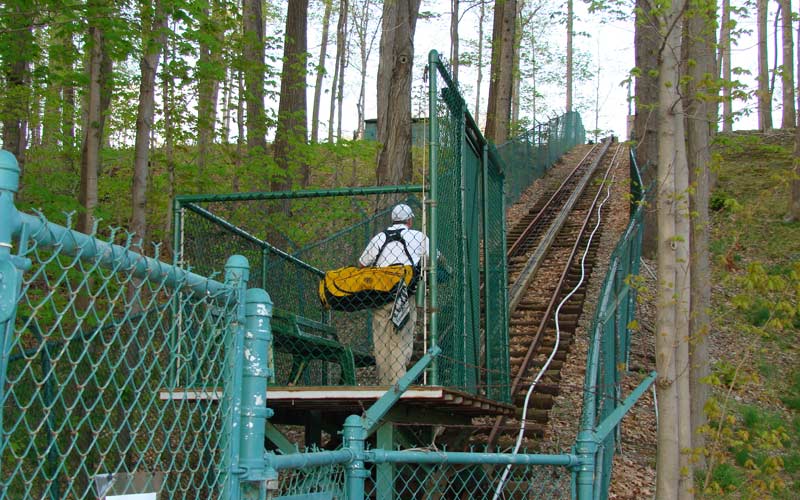
…taking the incline out of the river valley to the eighteenth tee.
Similar to the Cascades in Virginia, the more dramatic and scenic back nine overshadows the front. However, in both cases, it is a great mistake to underestimate the merits of the respective front nines. Regarding Kirtland’s, the pacing of the holes on the front is excellent with the fourth and fifth being the only consecutive holes that measure within thirty yards of each other (and that is deceiving as the uphill fourth plays much longer than its 415 yards and the downhill fifth plays shorter than its 385 yards). This highlights that a game at Kirtland is about variety, which is the true mark of all great courses. In fact, having spent weeks and weeks on-site studying the two nines, Nagle makes some interesting observations when he writes, ‘We had always heard that Kirtland had one of the best “member” nines in the country with its back nine featuring spectacular views and Alison’s use of the twisting Chagrin River. Happily, the challenge of the golf holes is every bit the equal of the scenic beauty which gives the back nine an emotional edge to those that play here. However, I must say the front nine never gives the golfer a break. Length of holes, severity of greens, elevation, and green alignment are continually challenging the golfer. Though it lacks the views presented on the back nine, the front has revealed itself to me as perhaps the greater challenge. The fact is simply that Kirtland is a complete golf course in all matters and that it is a great shame there is less of Mr. Alison’s work here in the States to enjoy!’
Alison’s talent for routing a course and designing holes that pass the test of time is nearly unmatched. If only more of his U.S. designs had been managed as well as this one at Kirtland, Alison would enjoy a greater reputation in this country. Regardless, with Hirono, Kawana, and Naruo in Japan, Royal Hague in the Netherlands, and Milwaukee and now Kirtland in the United States, there remains plenty of evidence that Charles Hugh Alison deserves a seat at the table reserved for the dozen greatest architects of all-time.
The End


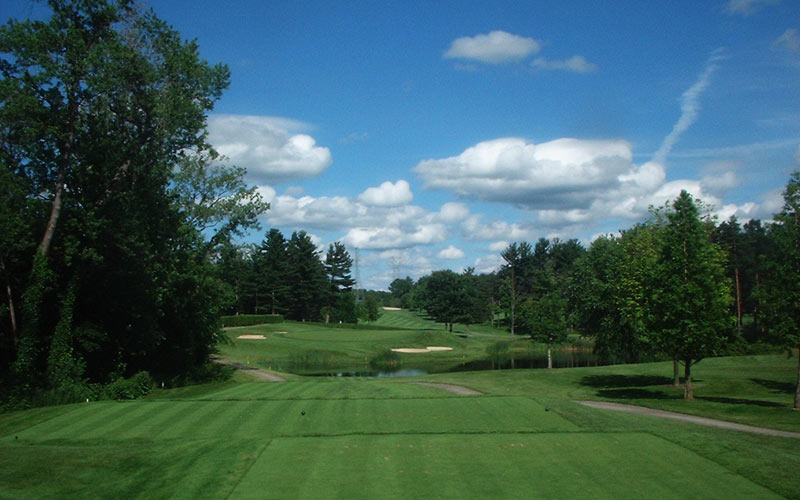



![The Park, West Palm (Lit 9) [2023]](https://golfclubatlas.com/wp-content/uploads/2024/12/IMG_7092-2-scaled-500x383.jpg)


